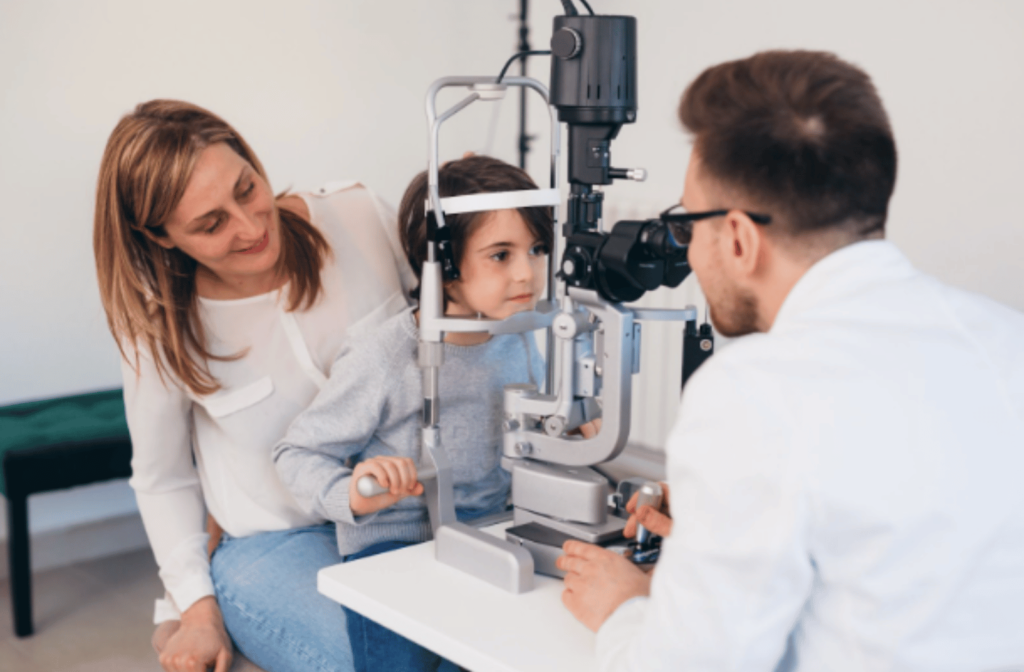As a parent, you want what’s best for your kids. Their vision plays an extremely important part in their quality of life. Healthy eyes and clear vision are a crucial part of childhood, and there’s an easy way to keep a close watch on your child’s vision—through regular children’s eye exams. You might be wondering, however, what exactly happens during a children’s eye exam? Let’s break it down.
During a children’s eye exam, your optometrist will check your child’s visual clarity and prescription. Then, they’ll thoroughly examine their eyes to determine how healthy they are, and they’ll keep an eye out for any potential problems. This lets them gain a proper understanding of your child’s development and gives them an opportunity to intervene and address any problems to help preserve your child’s vision in the long run.
What Is a Children’s Eye Exam?
Comprehensive eye exams are more important than most people think—and children are no exception to this rule! During a children’s eye exam, your optometrist is going to take their time and thoroughly examine your child’s vision and eyes.
This isn’t just about checking their vision, though. As your child grows, their eyes are going to be constantly growing and changing. Throughout their earlier years, they’ll be experiencing plenty of changes and adjustments. From vision differences to muscle alignment, there are plenty of developmental milestones to keep an eye out for—and your optometrist can help.
Through a series of different tests, your optometrist will check how your child’s eyes are growing and whether or not they’re at risk of developing certain conditions. This means that children’s eye exams are about more than getting a new prescription. It’s about making sure that your child’s eyes are developing as they should, and catching any potential problems long before they can have lifelong effects.
Think of it like a routine checkup for your child’s eyes that helps maintain and preserve their vision in the long run.
What to Expect from a Children’s Eye Exam
During the exam itself, your child’s optometrist is going to go out of their way to make sure your child feels comfortable. They’ll take the time to explain the process to your child and answer any questions your child may have. By prioritizing your child’s comfort, your optometrist will be able to create a welcoming environment that welcomes and embraces curiosity.
Then, you can expect the optometrist to test your child’s:
- Visual acuity (sharpness of vision)
- Eye alignment and coordination
- Depth perception
- Color vision
- Eye health and function
These tests may vary slightly depending on your child’s age. Younger children may be asked to identify different pictures, while older kids will likely be asked to read letters from a standard eye chart.
Throughout the exam, your optometrist will cycle through several different machines, each with its own individual purpose. Some help your optometrist see clearly inside the eye, while others are designed to check how light refracts as it enters the eye. If you or your child have any questions, feel free to ask!
How Often Should a Child Have an Eye Exam?
So, how often should you schedule a children’s eye exam? There are a few guidelines you can follow:
- The first-ever eye exam should be scheduled between the age of 6-9 months old
- At least 1 time between the age of 2-5
- Once a year between the ages of 6-19
If your child wears glasses or contacts, they may need to visit more often. This gives an optometrist the chance to monitor any potential changes in their vision and help maintain an up-to-date prescription.
Signs It’s Time for an Eye Exam
If your child is showcasing any of the following signs, you should schedule an eye exam sooner rather than later:
- Squinting or closing one eye to read or watch TV
- Complaining of headaches or eye strain
- Difficulty focusing on tasks at hand
- Sitting too close to screens or books
- Trouble with eye-hand coordination during play
- Avoiding activities that require detailed vision, like coloring or assembling puzzles
- Winking or rubbing eyes frequently
These are all indications of common vision problems in children, so if you notice these symptoms, it’s time for your child’s next eye exam.
Schedule Your Next Visit with Red Deer Eye Care
At Red Deer Eye Care, we’re committed to taking care of your child’s vision. Our team is here to help you and your child feel comfortable throughout the exam, and we welcome your questions! Whether your child needs a new prescription, advice on eye care, or if it’s time for their next eye exam, our clinic is here for your family. Book an appointment with us today!



